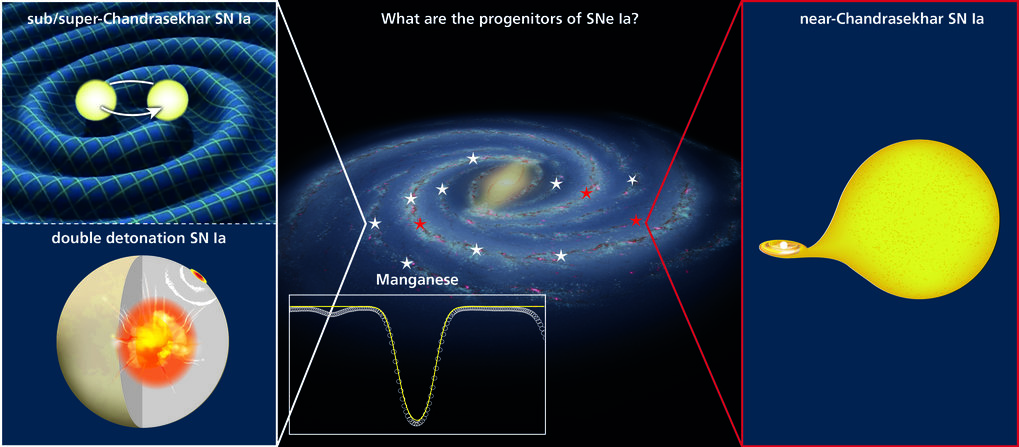Find out the latest thinking about our universe.
-
bystander
- Apathetic Retiree
- Posts: 21577
- Joined: Mon Aug 28, 2006 2:06 pm
- Location: Oklahoma
Post
by bystander » Fri Mar 06, 2020 4:33 pm
A Puzzle Piece from Stellar Chemistry Could
Change Our Measurements of Cosmic Expansion
Max Planck Institute for Astronomy | 2020 Mar 05
Astronomers led by Maria Bergemann (MPIA) have performed chemical measurements on stars that could markedly change the way cosmologists measure the Hubble constant and determine the amount of so-called dark energy in our universe. Using improved models of how the presence of chemical elements affects a star’s spectrum, the researchers found that so-called supernovae Type Ia have different properties than previously thought. Based on assumption about their brightness, cosmologists have used those supernovae to measure the expansion history of the universe. In light of the new results, it is now likely those assumptions will need to be revised.
Over the past decade or so, when Maria Bergemann, a Lise Meitner Research Group leader at the Max Planck Institute for Astronomy, developed improved ways of measuring the chemical properties of stars, she didn’t know that her research might one day affect the way that astronomers measure cosmic expansion, the Hubble constant, and the amount of Dark Energy in our universe. But via a series of unforeseen connections, that is what appears to be happening right now. Using the analysis tools Bergemann developed, the astronomers were able to trace the abundance of the chemical elements manganese and iron over the past 13 billion years of galactic history. Their (unexpected) result puts constraints on the properties of the stellar explosions, so-called Supernovae of Type Ia, which are needed to produce the element.
Observational Constraints on the Origin of the Elements III. Evidence for the Dominant
Role of Sub-Chandrasekhar SN Ia in the Chemical Evolution of Mn and Fe in the Galaxy ~ Philipp Eitner
et al
Know the quiet place within your heart and touch the rainbow of possibility; be
alive to the gentle breeze of communication, and please stop being such a jerk. — Garrison Keillor
-
neufer
- Vacationer at Tralfamadore
- Posts: 18805
- Joined: Mon Jan 21, 2008 1:57 pm
- Location: Alexandria, Virginia
Post
by neufer » Fri Mar 06, 2020 4:53 pm
https://en.wikipedia.org/wiki/SN_2003fg wrote:
<<SN 2003fg, sometimes called the "Champagne Supernova", was an unusual Type Ia supernova. It was discovered in 2003 with the Canada-France-Hawaii Telescope and the Keck Telescope, both on Mauna Kea in Hawaii, and announced by researchers at the University of Toronto. The supernova occurred in a galaxy some 4 billion light-years from Earth.
It was unusual because of the mass of its progenitor. According to the current understanding, white dwarf stars explode as Type Ia supernovas when their mass approaches 1.4 solar masses, termed the Chandrasekhar limit. The mass added to the star is believed to be donated by a companion star, either from the companion's stellar wind or the overflow of its Roche lobe as it evolves.
However, the progenitor of SN 2003fg reached two solar masses before exploding. The primary mechanism invoked to explain how a white dwarf can exceed the Chandrasekhar mass is unusually rapid rotation; the added support effectively increases the critical mass. An alternative explanation is that the explosion resulted from the merger of two white dwarfs. The evidence indicating a higher than normal mass comes from the light curve and spectra of the supernova—while it was particularly overluminous, the kinetic energies measured from the spectra appeared smaller than usual. One proposed explanation is that more of the total kinetic energy budget was expended climbing out of the deeper than usual potential well.
This is important because the brightness of type Ia supernovae was thought to be essentially uniform, making them useful "standard candles" in measuring distances in the universe. Such an aberrant type Ia supernova could throw distances and other scientific work into doubt; however, the light curve characteristics of SN 2003fg were such that it would never have been mistaken for an ordinary high-redshift Type Ia supernova.>>
https://en.wikipedia.org/wiki/P-nuclei#subChandrasekhar_supernovae wrote:
<<In a subclass of type Ia supernovae, the so-called subChandrasekhar supernova, the white dwarf may explode long before it reaches the Chandrasekhar limit because nuclear reactions in the accreted matter can already heat the white dwarf during its accretion phase and trigger explosive carbon burning prematurely. Helium-rich accretion favors this type of explosion. Helium burning ignites degeneratively on the bottom of the accreted helium layer and causes two shockfronts. The one running inwards ignites the carbon explosion. The outwards moving front heats the outer layers of the white dwarf and ejects them. Again, these outer layers are site to a γ-process at temperatures of 2-3 GK. Due to the presence of α particles (helium nuclei), however, additional nuclear reactions become possible. Among those are such which release a large number of neutrons, such as
18O(α,n)
21Ne,
22Ne(α,n)
25Mg, and
26Mg(α,n)
29Si. This allows a pn-process in that part of the outer layers which experiences temperatures above 3 GK.
Those light p-nuclei which are underproduced in the γ-process can be so efficiently made in the pn-process that they even show much larger abundances than the other p-nuclei. To obtain the observed solar relative abundances, a strongly enhanced s-process seed (by factors of 100-1000 or more) has to be assumed which increases the yield of heavy p-nuclei from the γ-process.>>
Art Neuendorffer
